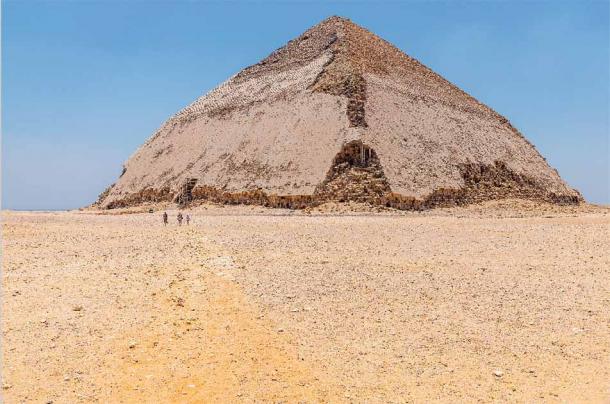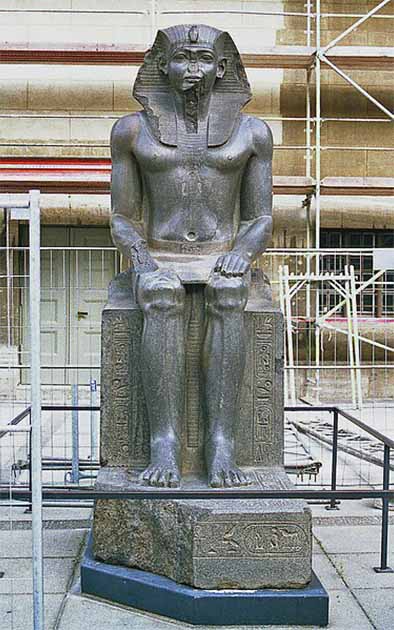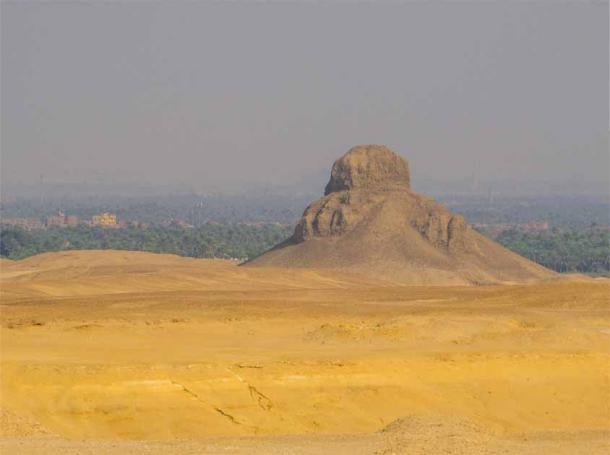
Exposing Egypt's Military Zone Protected Dahshur Necropolis
The cult of death played a crucial role in the history of ancient Egypt - they believed that their souls would continue to exist in the afterlife after they died. The concept of the afterlife was very similar to that of the living world, so the souls needed a place to return to. The landscape of Egypt is dotted with tombs, pyramids, and temples all dedicated to providing the deceased with a home to reside in, and the Dahshur necropolis, 40 kilometers (25 miles) south of Cairo, is an important site, but one of the least visited sites in Egypt. It had been a military zone until 1996 and is therefore not as commercially developed as Giza. This location was used as a burial ground by pharaohs and royal family members of the Old and Middle Kingdoms. Here, Sneferu perfected the “true” pyramid, adding to the grandeur of the Egyptian afterlife.
The Beginning of Dahshur Necropolis
Pharaoh Sneferu came to power in 2613 BC, and like his predecessors, he started to prepare for his afterlife soon after taking over. However, for his funeral arrangements, Sneferu wanted a completely new burial ground, therefore he moved six miles south of Memphis to a new site called Dahshur. It was here that the pharaoh commissioned the first smooth-sided pyramid. They initially started with a 60-degree angle but halfway into construction cracks began appearing due to which the architects decided to change the angle for the remaining part to 43.9 degrees. This created an unusual shape, now known as the Bent pyramid.
- Book of the Dead: Ancient Egypt’s Quest for Eternal Life (Video)
- Entrance to 3,700-Year-Old Previously Unknown Pyramid Discovered in Egypt
The Bent pyramid does look rather odd when compared to the straight lines of later examples, however, some Egyptologists have suggested its shape intentionally replicates that of the mound of creation, and its two distinct angles represent Upper and Lower Egypt. Whatever the intention behind the shape had been, the cracks in the interior led to it being abandoned and Sneferu commissioned a second pyramid four kilometers north. This was one of the most laborious rebuild projects in history and all available men were mobilized to work on the massive project.

The Bent Pyramid of Sneferu, Dashur Necropolis, Egypt. (Nick Brundle/Adobe Stock)
The architects had learned from their previous mistake, and this time they decided on a 43-degree angle, which reached a height of 104 meters (39.3 in). Dr. Joanna Fletcher describes the importance of the “Red Pyramid” or “Northern Pyramid” in her book, “The Story of Egypt”:
“…this ‘Northern Pyramid’ still dominates the Dahshur skyline, a true testament to Snefru’s vision and the great tenacity of his architects. But this was not just a stairway to climb to the stars; this pyramid was the perfect architectural analogy for the way Snefru’s soul would be reborn, its apex topped by a gilded capstone designed to catch the first rays of the sun, whose reviving powers would then be transmitted directly downwards, into the body of the king.”
Snefru’s wives and children were buried close to him, so they could share his sun-drenched afterlife, and even important nobles were buried alongside their king in smaller mastabas. The importance of Snefru’s monuments is explained by Dr. Zahi Hawass, renowned Egyptologist, who conducted extensive research at the Dahshur necropolis. He notes:
“The Red Pyramid and the Bent Pyramid are two of the most important pyramids in Egypt, not only for their architectural innovations but also for their historical significance. They are a testament to the ambition and skill of the ancient Egyptians and continue to fascinate visitors and scholars alike.”
However, Snefru’s son Khufu decided to move the burial ground again and made his pyramid in Giza. And it wasn’t until the 12th dynasty that Dahshur once more became an important burial site.

Red pyramid of King Sneferu at Dahshur, Cairo, Egypt. (icon72/ Adobe Stock)
12th Dynasty Pyramids
For 700 years the site at Dahshur lay undisturbed, only Snefru’s pyramids marking the landscape, however, in the 12th Dynasty, Dahshur once more became a burial ground for the pharaohs and their family.
In 1985 BC, Amenemhat I took the throne and the first thing that he did was to begin preparations for his afterlife. Notice the trend. While he established his burial site at Lisht, his architects reused entire sections from the pyramids at Dahshur, Giza, and Sakkara. Since the sites had already been damaged, the reuse of material could have been inspired by piety, as well as a desire to harness the greatness of the Pyramid Age.

Colossal statue of Amenemhat II. (Juan R. Lazaro/CC BY 2.0)
His grandson, Amenemhat II, however, decided to return to Dahshur, to build his pyramid. Unlike his ancestors, Amenemhat II did not attempt to replicate massive monuments. His tomb is called the “White Pyramid” because of the white limestone that once formed its outer casing, unfortunately, now it is all a pile of broken rubble. The king’s burial chamber had been stripped of all its artifacts and only had an empty sarcophagus. Later expeditions in 1894 revealed that there were subterranean tombs of at least one of his queens, Kemanub, and daughters Sathathormerty, Itaweret, Khnumet, and Ita. This showed that like Snefru, Amenemhat II buried his family members close to his resting place.
The next ruler to build in Dahshur was Sesostris III, his pyramid was located northeast of the Red Pyramid, the largest of the pyramids, created by the 12th Dynasty pharaohs.
Dr. Joann Fletcher writes:
“The pyramid’s seventy-eight-meter-high superstructure of mud-brick was once overlaid in limestone and its subterranean chambers, smaller than their counterpart at Abydos, were likewise lined in limestone; his burial chamber had been built of granite, but was found empty, save for a bronze dagger, some pottery, and a dust-filled sarcophagus.”

View of the Pyramid of Amenemhat III (or Black Pyramid) in Dahshur necropolis, Egypt. (Diego Fiore/Adobe Stock)
Following his father’s footsteps, Amenemhat III began to prepare his funerary arrangements at Dahshur. The first fifteen years of his reign were occupied by work on his pyramid, which was topped with an impressive granite capstone carved with his eyes, to ‘behold the perfections of Ra’. Like his predecessors, the pyramid complex featured tombs for the royal family members, beyond them, tombs for courtiers and officials were constructed. Unfortunately, the Dahshur plateau was unable to cope with the scale of the building, thus cracks began appearing in the finished pyramid.
Just like Snefru, Amenemhat III’s architects had to rebuild the funerary monument, thus the pyramid was abandoned, and the burial location changed.
- Is There More to the Mechanics of the Great Pyramid?
- Hidden Chambers and Meaning: Is the Great Pyramid for a King or Priests?
13th Dynasty Pyramids
In 1957, an American expedition discovered a small and heavily damaged pyramid. From the archaeological evidence, they concluded that the pyramid belonged to Ameny-Qemau. Very little is known about his rule, but what is known is that he ruled Egypt during the 13th Dynasty’s Second Intermediate Period. Originally the Pyramid was about 50 meters tall (164 ft), but the outer structure has been destroyed. Luckily the substructure has survived, but it was plundered by grave robbers, thus archaeologists only recovered fragments of the canopic chest. This was the last monumental pyramid built in Egypt during the Middle Kingdom. Very few pyramids were built during the later dynasties.
Each pyramid located in Dahshur has filled in the gaps with information regarding the various Dynasties. Snefru was an ambitious pharaoh who created the first “true” pyramid, and it was his architects who set the precedent for future generations. However, the grand structures, despite all their defenses, could not escape tomb robbers, which left these monuments barren of much important archaeological evidence.
Top image: A view of the The Dahshur necropolis in Egypt, from the Saqqara necropolis. Source: Blumesser/Adobe Stock
References
2019. Secrets of the Lost Pyramids. The Lost Treasures of Egypt, National Geographic,
Alexanian, N, et al. 2009. The Necropolis of Dahshur. Seventh Excavation Report Autumn.
2019. Secrets of the Lost Pyramids. The Lost Treasures of Egypt, National Geographic,
Alexanian, N et al. 2012. The pyramid complexes and the ancient landscape of Dahshur/Egypt.
Fletcher, J. 2016. The story of Egypt. Simon and Schuster
Gaballah, M et al. 2006. "Detection of the buried archaeological structures at a site of Dahshur Necropolis, Giza, Egypt." In Proceedings of the 8th SEGJ International Symposium, pp. 1-6. Society of Exploration Geophysicists of Japan,
Yoshimura, S et al. 1997. A preliminary report of the general survey at Dahshur North, Egypt. Collegium Mediterranistarum















